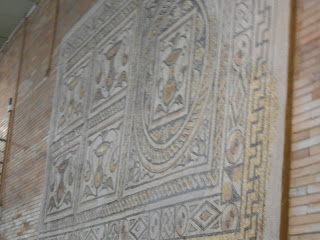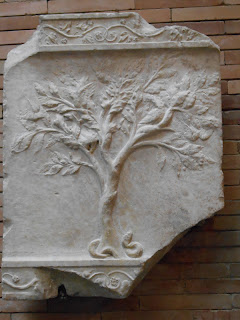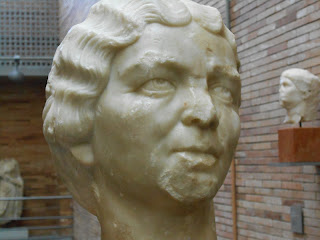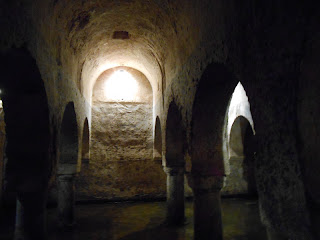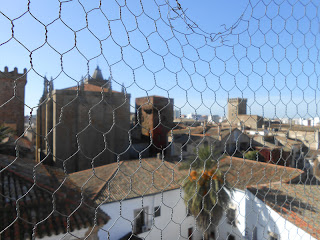I woke up at 6:30 Monday morning, all excited for the five-day trip to Cáceres! As I waited for the 34 bus, I was a bit nervous because I didn't know if I had enough time to make it to the Estación de las Delicias (The Delicias Station). It was 7:35 am and I had to be there at 8. I arrived with time to spare. Even if I had been a few minutes late, it would've been okay because the train we were taking wouldn't leave until 8:30. The two teachers accompanying us, Oriol and Álvaro, just wanted to make sure we got there with enough time. The train, called El Ave, is the fastest train in Spain. As a comparison, the train would take an hour and a half to get to Madrid (where we were going) compared to four hours on a bus. Quite a difference, which is why we took the train in the first place I'm guessing. If we had taken a bus from Zaragoza, the trip to Extremadura would've been about 7 hours. Too long.
 |
| Us waiting inside the Estación de las Delicias |
El Ave was very nice. It glided across the earth, and its shadow weaved back and forth on the hills, looking like a snake. Inside all the seats had a headrest, a table, and a footrest. There were also mini-TV's. It was basically like the inside of a small plane.
 |
| El Ave! |
 |
| Madrid! |
Upon arriving in Madrid we walked straight to the bus that would take us to Extremadura. It was parked outside the station, so we were able to see a tiny part of Madrid! The capital of Spain! Like the train, the bus was also very comfortable. Apparently the typical yellow school bus we associate with the US doesn't exist here, so for all of our school trips we get luxury buses, which are huge and, as I've already said, very comfy. The bus ride took about four hours, and the first city we visited in Extremadura was Trujillo.
 |
| We've finally in Extremadura! |
 |
| The countryside |
 |
| Cows |
Now back to Trujillo. We arrived in the city after lunch, which we had eaten in a restaurant. The bus dropped us off in the central plaza (La Plaza Mayor). It was very pretty. There was a fountain and next to it a statue of Pizarro mounted on a horse. He was born in Trujillo. Álvaro gave us all maps of the city with arrows that we followed. The city has many palaces built by the families of the conquistadors. They are very rectangular and closed off. We did not see the inside of any of them. We climbed to the top of the city and there we saw a castle. But that was insignificant compared to the view! On top of the hill, we could see for miles. Very green grass, ancient walls, the mountains in the distance. It was beautiful.
 |
| Us in front of the statue of Fernando Pizarro in the Plaza Mayor of Trujillo |
 |
| One of the palaces built by the conquistadors' families |
 |
| Climbing to the top of Trujillo |
 |
| The castle! |
 |
| Me and Sydney |
 |
| Amazing view, very green with a lot of Roman ruins |
 |
| Me and Gabby |
 |
| Walking back down |
 |
| Interesting looking building (Jordan) |
We boarded the bus and drove to the second city, Cáceres, where we stayed in a hotel for the first three nights. The hotel was called Alfonso IX, who was a Spanish king. Oriol and Álvaro assigned us our rooms and roommates. I like both my room and roommate. We stayed on the third floor and we we got a good view from our only window. For the rest of the day we had free time, so three friends (Nate, Kaitlyn, and Sydney) and I walked around our new home for the next four days. When we decided to eat dinner, we chose a small Italian restaurant. I had a sub with meat, tomatoes, lettuce, and mayonnaise with tutti-frutti ice cream for dessert. We remained in the restaurant for about an hour, talking and laughing. I really enjoyed it.
 |
| My room in Cáceres! |
 |
| The view from my room's window |
 |
| The hotel's dining room |
 |
| The Roman aqueduct! |
 |
| Kaitlyn, Sydney, and me |
 |
| All of us with Álvaro! He's wearing the green sweater. |
 |
| All of us with Oriol! He's wearing the gray sweater with sunglasses. |
 |
| The storks! Cigueñas. |
 |
| The Museum of Roman Art |
 |
| A model of the Roman Mérida. |
 |
| Ideal Restitution 25 B.C. - 1300's A.D. Scale: 1/1000 |
 |
| Paintings of the gladiator and animal fights. |
 |
| Top of a Corinthian column. |
 |
| Sundial. |
 |
| A Roman god. |
 |
| A full column. |
 |
| Mosaic. |
 |
| The old Roman road. |
 |
| I think this was the dining room in the house. |
 |
| What the house would've looked like. |
 |
| The statue of Romulus and Remus. |
 |
| The Roman temple. |
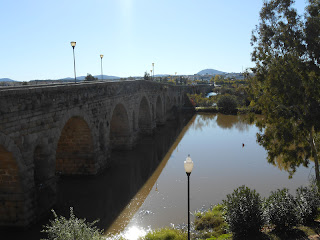 |
| The very long bridge! |
 |
| The Guadiana River! |
 |
| Nate, Sydney, and Kaitlyn |
 |
| The amphitheater! |
 |
| The Roman theater! |
 |
| The stage. |
 |
| The chorus where the authorities sat. |
 |
| The beautiful sunset. |
 |
| The symbol in the shape of the Iberian Peninsula. |
 |
| Banners. |
 |
| The building made with bricks. |
 |
| The door where people can ask the nuns for sweets. |
 |
| The treat Álvaro bought for us. |
 |
| The cistern. |
 |
| The San Francisco Javier Church. |
 |
| The golden-covered front. |
 |
| View from a tower on top of the church. |















